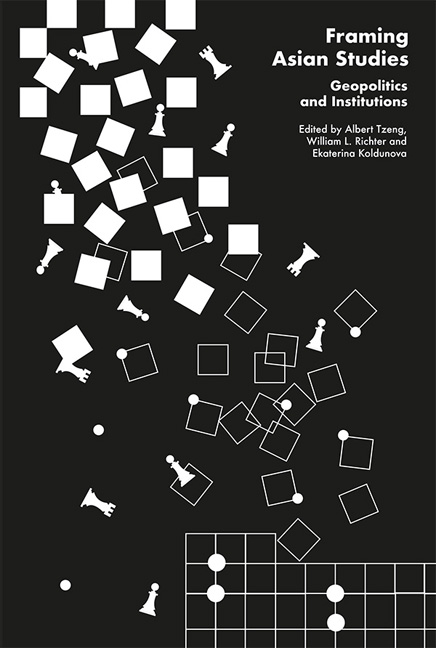Book contents
- Frontmatter
- Contents
- Foreword
- The Contributors
- 1 Introduction: Framing Asian Studies
- I Contested “Asia”
- 2 From Oriental Studies to Asian Studies: The Metamorphosis of the Western Mind
- 3 Geopolitical and Social Framings of Australia's “Asia Literacy”
- 4 Maps as Illustrations and Logos: Geopolitical Construction of Asia and South Asia
- II Geopolitical Framing of Western Discourse
- III Asian Studies in Former Soviet States
- IV Inter-Asian Gazes
- Index
4 - Maps as Illustrations and Logos: Geopolitical Construction of Asia and South Asia
from I - Contested “Asia”
Published online by Cambridge University Press: 28 June 2018
- Frontmatter
- Contents
- Foreword
- The Contributors
- 1 Introduction: Framing Asian Studies
- I Contested “Asia”
- 2 From Oriental Studies to Asian Studies: The Metamorphosis of the Western Mind
- 3 Geopolitical and Social Framings of Australia's “Asia Literacy”
- 4 Maps as Illustrations and Logos: Geopolitical Construction of Asia and South Asia
- II Geopolitical Framing of Western Discourse
- III Asian Studies in Former Soviet States
- IV Inter-Asian Gazes
- Index
Summary
“What constitutes Asia?” is a question central to the field of Asian Studies. A geographical term that is attached to a seemingly stable, objectively defined, landmass, “Asia” is in reality a socially constructed concept that has constantly been reshaped or appropriated with changing emphasis. This study considers the question of how Asia and South Asia are portrayed (represented, framed, constructed) by the maps on the covers of books and scholarly journals and by map logos of professional associations. It asks how each region (South Asia and Asia generally) is defined, which features are emphasized or marginalized, and what sorts of distortions are evident. An old adage admonishes us not to judge a book by its cover, but the covers of books and journals are designed to attract readers, to allude to content and to connect with existing perceptions. It is worthwhile to explore what these map illustrations reveal.
Examples of such portrayal may be seen in the two scholarly books that initially prompted this inquiry. Both showed South Asia, but the maps were truncated, distorted or otherwise modified. The cover of C. Raja Mohan's Crossing the Rubicon: The Shaping of India's New Foreign Policy (2003) shows a map of India in vivid orange. Border areas are sufficiently blurred so that one cannot read the names of any other countries except India and Nepal. The map on the cover of Baldev Raj Nayar and T.V. Paul's India in the World Order: Searching for Major-Power Status (2003) appears to be looking eastward at India on a globe. India, Nepal, Bhutan, and Myanmar (Burma) are labelled, as are the visible Indian states, but the map is truncated at top and bottom so that three northern states (Punjab, Himachal Pradesh, Jammu and Kashmir) and three southern states (Karnataka, Kerala, Tamil Nadu) are not visible or labelled. Pakistani territory is shown but not labelled as such.
There may be various reasons for such distortions, including having an “eye-catching” book cover, but there also appear to be geopolitical considerations. The former princely state of Jammu and Kashmir has been a source of conflict between India and Pakistan since the two countries became independent in 1947. India regards all as an integral part of the Indian Union. Pakistan regards the entire state to be disputed territory.
- Type
- Chapter
- Information
- Framing Asian StudiesGeopolitics and Institutions, pp. 64 - 98Publisher: ISEAS–Yusof Ishak InstitutePrint publication year: 2018



